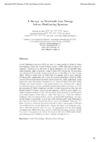Identificador persistente para citar o vincular este elemento:
https://accedacris.ulpgc.es/handle/10553/70818
| DC Field | Value | Language |
|---|---|---|
| dc.contributor.author | De Blasio , Gabriele Salvatore | en_US |
| dc.contributor.author | Quesada Arencibia, Francisco Alexis | en_US |
| dc.contributor.author | García Rodríguez, Carmelo Rubén | en_US |
| dc.contributor.author | Rodríguez Rodríguez, José Carlos | en_US |
| dc.date.accessioned | 2020-03-10T14:26:39Z | - |
| dc.date.available | 2020-03-10T14:26:39Z | - |
| dc.date.issued | 2019 | en_US |
| dc.identifier.isbn | 978-84-09-09208-6 | en_US |
| dc.identifier.other | 17th International Conference on Computer Aided Systems Theory, Eurocast 2019. Extended Abstracts / Alexis Quesada-Arencibia; José Carlos Rodríguez-Rodríguez; Roberto Moreno-Díaz; Roberto Moreno-Díaz jr; Gabriel de Blasio; Carmelo Rubén García (edits), p. 29 | - |
| dc.identifier.uri | https://accedacris.ulpgc.es/handle/10553/70818 | - |
| dc.description.abstract | Indoor Positioning Systems (IPS) are used to locate people or things in those environments where the Global Position System (GPS) fails due to signal attenuation. Depending on the type of signal employed, can be classified into: radio frequency, light, sound and magnetic fields IPS systems [3]. Among those technologies which use radio frequency signals we can find Bluetooth Low Energy (BLE) which is widely used in Ubiquitous Computing and in many Internet of Things (IoT) applications [2]. There are several advantages o↵ered by BLE: their emitters or beacons are portable, battery-powered, small, lightweight, easily deployable, have low-energy consumption and Received Signal Strength (RSS) readings (the measurements of the power present in a received radio signal) are relatively easy to collect, producing positioning results with high accuracy and precision [4]. BLE technology can also provide advanced services that are directly linked to indoor positioning and especially useful in many places, e.g. public transport stations: in such environments, these services can provide users with station guides, ticket sales or online information [1]. There are di↵erent challenges when working in indoor positioning using BLE technology, for example the signal is susceptible to path loss, RSS readings su↵er large fluctuations and degradation due to dynamical environments or multipath fading [5]. Another important challenge associated with BLE indoor positioning is the fact that mobile devices do not distinguish between the three radio frequency channels in which the beacons emit, so using the aggregation of these three signals combining their RSS values, may lead to a reduced positioning accuracy [6], [2]. The aim of this paper is to review the state of the art of BLE-based indoor positioning systems including its main methods and algorithms. | en_US |
| dc.language | eng | en_US |
| dc.publisher | Universidad de Las Palmas de Gran Canaria (ULPGC) | en_US |
| dc.source | EUROCAST 2019. Computer Aided Systems Theory. Extended abstracts / Alexis Quesada-Arencibia; José Carlos Rodríguez; Roberto Moreno-Díaz; Roberto Moreno-Díaz jr.; Gabriel de Blasio; Carmelo Rubén García (eds.), p. 29-30 | en_US |
| dc.subject | 1203 Ciencia de los ordenadores | en_US |
| dc.subject.other | Indoor positioning | en_US |
| dc.subject.other | Bluetooth low energy | en_US |
| dc.title | A survey on bluetooth low energy indoor positioning systems | en_US |
| dc.type | info:eu-repo/semantics/conferenceobject | en_US |
| dc.type | ConferenceObject | en_US |
| dc.relation.conference | International Conference on Computer Aided Systems Theory (EUROCAST 2019) | en_US |
| dc.investigacion | Ingeniería y Arquitectura | en_US |
| dc.type2 | Actas de congresos | en_US |
| dc.utils.revision | Sí | en_US |
| dc.identifier.ulpgc | Sí | en_US |
| dc.contributor.buulpgc | BU-INF | en_US |
| item.fulltext | Con texto completo | - |
| item.grantfulltext | open | - |
| crisitem.author.dept | GIR IUCES: Computación inteligente, percepción y big data | - |
| crisitem.author.dept | IU de Cibernética, Empresa y Sociedad (IUCES) | - |
| crisitem.author.dept | Departamento de Informática y Sistemas | - |
| crisitem.author.dept | GIR IUCES: Computación inteligente, percepción y big data | - |
| crisitem.author.dept | IU de Cibernética, Empresa y Sociedad (IUCES) | - |
| crisitem.author.dept | Departamento de Informática y Sistemas | - |
| crisitem.author.dept | GIR IUCES: Computación inteligente, percepción y big data | - |
| crisitem.author.dept | IU de Cibernética, Empresa y Sociedad (IUCES) | - |
| crisitem.author.dept | Departamento de Informática y Sistemas | - |
| crisitem.author.dept | GIR IUCES: Computación inteligente, percepción y big data | - |
| crisitem.author.dept | IU de Cibernética, Empresa y Sociedad (IUCES) | - |
| crisitem.author.dept | Departamento de Informática y Sistemas | - |
| crisitem.author.orcid | 0000-0002-6233-567X | - |
| crisitem.author.orcid | 0000-0002-8313-5124 | - |
| crisitem.author.orcid | 0000-0003-1433-3730 | - |
| crisitem.author.orcid | 0000-0003-2186-3094 | - |
| crisitem.author.parentorg | IU de Cibernética, Empresa y Sociedad (IUCES) | - |
| crisitem.author.parentorg | IU de Cibernética, Empresa y Sociedad (IUCES) | - |
| crisitem.author.parentorg | IU de Cibernética, Empresa y Sociedad (IUCES) | - |
| crisitem.author.parentorg | IU de Cibernética, Empresa y Sociedad (IUCES) | - |
| crisitem.author.fullName | De Blasio, Gabriele Salvatore | - |
| crisitem.author.fullName | Quesada Arencibia, Francisco Alexis | - |
| crisitem.author.fullName | García Rodríguez, Carmelo Rubén | - |
| crisitem.author.fullName | Rodríguez Rodríguez, José Carlos | - |
| crisitem.event.eventsstartdate | 17-02-2019 | - |
| crisitem.event.eventsenddate | 22-02-2019 | - |
| Appears in Collections: | Actas de congresos | |
Page view(s)
234
checked on Feb 10, 2024
Download(s)
175
checked on Feb 10, 2024
Google ScholarTM
Check
Altmetric
Share
Export metadata
Items in accedaCRIS are protected by copyright, with all rights reserved, unless otherwise indicated.
